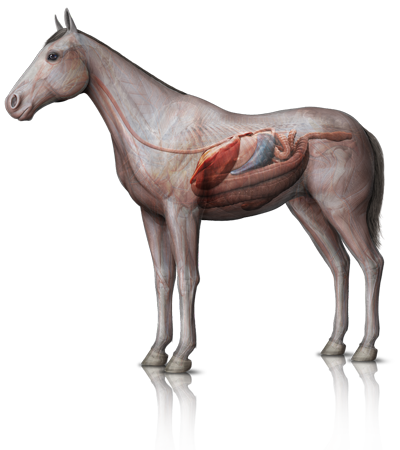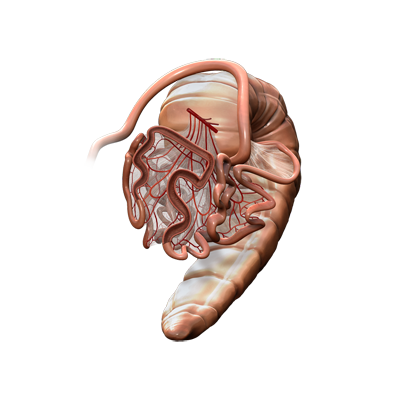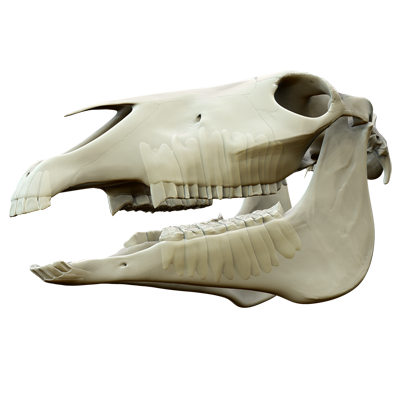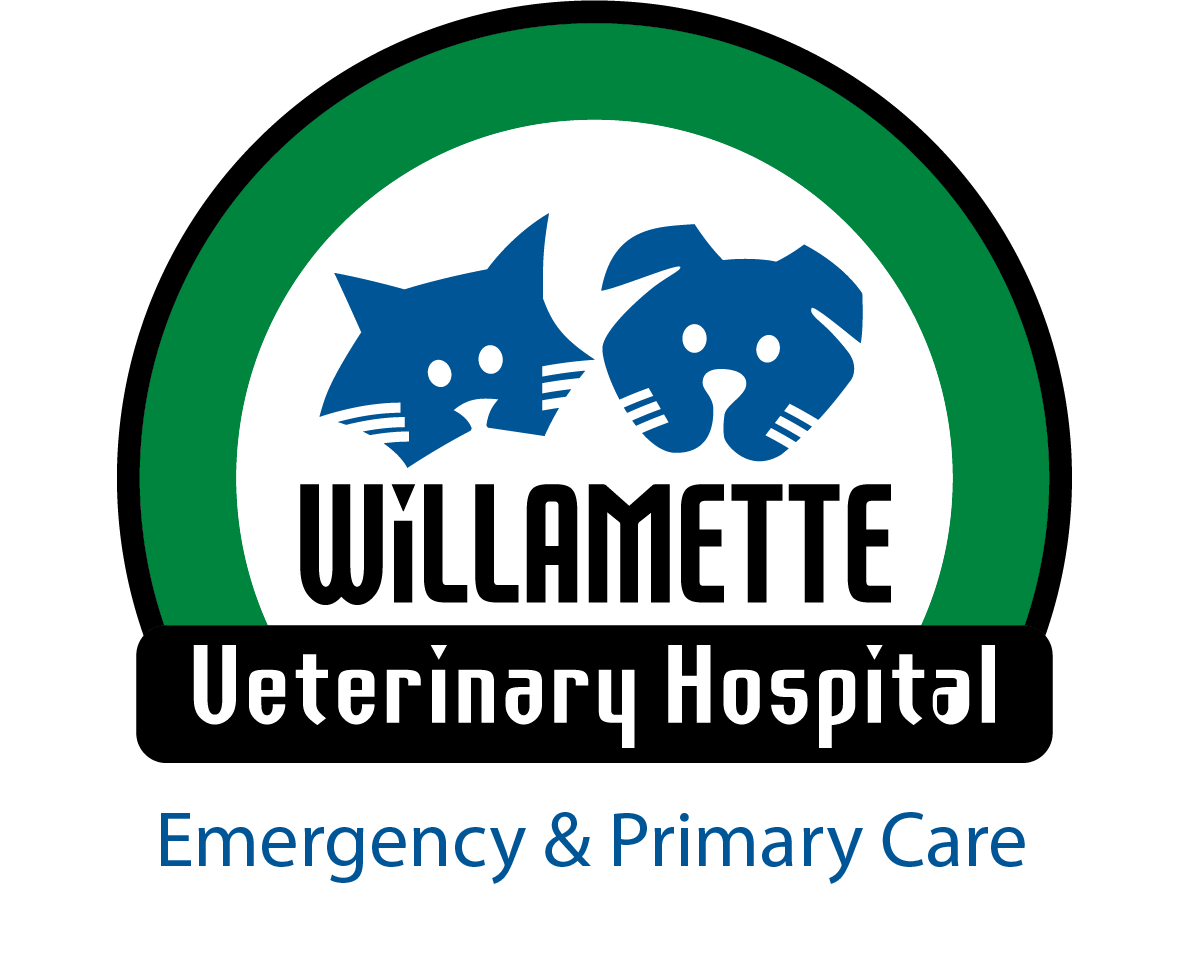
Problems related to the sensitive equine digestive system represent one of the most common medical problems seen by veterinarians. The design of the horse’s digestive system meets the specific needs of an herbivore: absorption of nutrients from fibrous plant material.
The equine digestive system begins at the mouth. Food enters the mouth; chewing action, from the large molar teeth, grinds the food into smaller particles. Oral enzymes act on the food particles to begin the digestive process. From the oral cavity, the road to digestion leads down the four foot long esophagus to enter the stomach. Once in the stomach, secretion of acids further separates food particles. As food material enters the small intestine, pancreatic secretions and bile begin to digest fats, simple sugars, and proteins. Food material not digested in the 50-70 feet of small intestine enters the cecum for further breakdown. The four foot long cecum contains a delicate balance of bacteria to ferment the complex sugars (cellulose) that remain in the intestinal tract. After fermentation, cecal contents enter the large intestine. The large intestine contains two segments: the large and small colons. The 10 foot large colon absorbs the fermented sugars released from the cecum. The small colon absorbs water to maintain hydration.
Indications of problems within the equine digestive system include: lack of an appetite, drooling, looking back at the abdomen, kicking at the abdomen, rolling on the ground, weight loss, and poor performance. It is important to note that horses cannot vomit to expel stomach contents like many other animals.
Many digestive problems in horses result from dental disease, poor quality feed, and sudden dietary changes. Dental disease can be avoided by routine oral examinations by your veterinarian and floating the teeth. Poor oral health may cause: choke (esophageal obstruction), bowel obstruction, and colic. Dietary causes of intestinal upset can lead to colic: abdominal pain.
Causes of colic include :
- Colon torsion
- Gastric impaction, dilatation, and rupture from poor dental health or poor quality feed
- Gastrointestinal ulcers in foals
- Infectious causes: Salmonellosis, Clostridiosis, Potomac Horse Fever
- Large colon displacements
- Large colon impaction; enteroliths; sand impaction
- Parasites: Strongyles, Ascarids
- Toxins: Blister Beetles, Aflatoxins
Digestive problems in horses need to be treated aggressively to avoid the development of laminitis.
Cecum

The equine large intestine can be divided into three major segments: the cecum, the large colon, and the small colon. The small intestine empties into the four foot long cecum. The cecum contains large numbers of bacteria and protozoa that digest the dietary plant fibers. In addition, these bacteria process proteins and produce essential vitamins for the horse. After exiting the cecum, the digesta enters the 10-12 foot long large colon for absorption of the bacteria-produced nutrients formed in the cecum. Abnormalities of the equine cecum are a cause of colic:
- Impactions: may be precipitated by dehydration or neurologic dysfunction
- Perforations: fatal complication of cecal impaction
Dentition

Has your horse become head shy? Gone off feed? Developed bouts of colic? These signs can be associated with dental problems in your horse’s mouth. A horse with dental pain may also drool, eat more slowly, and drop food. Poor oral health results in pain and insufficient chewing of food, which may cause choke (esophageal obstruction), bowel obstruction, and colic. Regular dental examinations by your veterinarian help detect tooth problems early before they become advanced. The frequency of dental examinations will depend on your horse’s diet and inherent tooth strength.
Esophagus

The path to digestion begins in the esophagus, a long hollow tube that connects the mouth with the stomach. Esophageal irritation manifests as regurgitation. Regurgitation occurs when swallowed food is expelled back out the mouth or nasal passages before entering the stomach. The most common cause of regurgitation is choke, an obstruction within the esophagus caused by a foreign object or poorly chewed food. Choke requires immediate veterinary attention to avoid complications (e.g.: infection, rupture). Other causes of esophageal inflammation include: strictures, tumors, and megaesophagus (enlarged, dilated esophagus).
Gastrointestinal System (GI)

Large Colon

After exiting the cecum, the digesta enters the 10-12 foot long large colon for absorption of the bacteria produced nutrients formed in the cecum. Problems within the large intestine are the most common cause of colic in the horse. Signs of colic include: kicking at their abdomen, rolling, and a poor appetite. Colic requires immediate veterinary attention. Disorders causing large intestinal pain include: sudden diet changes (i.e.: grain excess), impactions from food (often related to poor dental health), enteroliths, displacements, infections (e.g.: Salmonella), Blister beetle toxicity, and parasites (e.g.: Strongyles).
Liver

A horse’s liver rests against the diaphragm, next to the stomach in the abdominal cavity. The liver performs many necessary functions to prevent illness:
- filters and detoxifies blood coming from the intestinal tract and other parts of the body
- aids in fat and sugar metabolism
- production of bile, proteins, and vitamins
Symptoms of liver disease vary based on the degree of failure present: jaundice (yellow tint to the skin), weight loss, behavior changes, and colic. Diagnosis of liver disease requires laboratory testing. Common causes of liver disease include: infections (e.g.: Tyzzer’s disease), inflammation (e.g.: chronic active hepatitis), toxicities (e.g.: toxic plant ingestion), and tumors (e.g.: carcinomas).
Small Colon

Small Intestine

The small intestine, named for its small diameter, spans roughly 50-70 feet in length. As food material exits the stomach, it enters the small intestine and mixes with pancreatic secretions and bile. These secretions break down food to allow absorption of proteins, sugars, and fats. Horses with small intestinal disease show signs of colic: kicking at their abdomen, rolling, and a poor appetite. Common causes of small intestinal disease include: 1) obstructions from foreign bodies, poorly digested food (i.e.: poor dental health), strangulations (i.e.: bowel becomes constricted around a fatty tumor in the abdomen), and intussusceptions (telescoping of the intestine) and 2) infectious causes: bacterial, viral, and parasitic. Colic requires immediate veterinary attention.
Stomach

After exiting the esophagus, food enters the stomach to begin the digestive process. The stomach mechanically and chemically separates food into smaller pieces prior to entry into the small intestine. Due to anatomical differences, horses cannot vomit. This inability to vomit predisposes horses to colic. Horses with colic may “dog sit”, roll on the ground, and/or look back and kick at their abdomen. Stomach-related colic may be caused by ulcerations, impaction, or dilatation of the stomach. Colic requires immediate veterinary attention.
Teeth

RostralCaudal Hooks
Abnormally long sections of tooth seen on the front of the first upper cheek tooth and the back of the last lower cheek tooth are called hooks. They develop from misalignment and abnormal wear of the rows of cheek teeth in a rostral to caudal, or front to back direction. The presence of hooks can cause local pain while chewing and also pain from the temporomandibular joint.
Wave Mouth
A wave mouth can be attributed to an uneven wear pattern caused by either dental pain, abnormal eruption, or loss of teeth. This is most commonly seen when the lower 3rd and 4th cheek tooth is long and the upper opposing teeth are abnormally short. This condition requires frequent dental care and management.
What's Next
Call us to schedule an appointment
Meet with a doctor for an initial exam.
Put a plan together for your pet.

